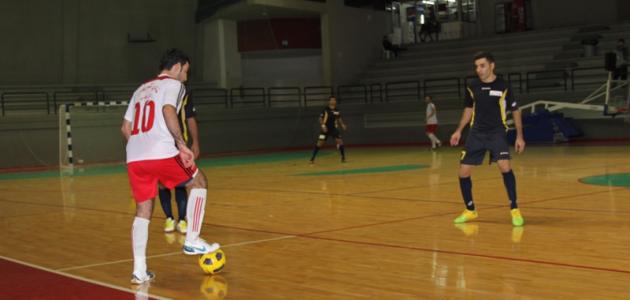Futsal
Futsal, or as it is known as five-a-side football (in English: Futsal), is considered one of the official types of football that is recognized by the International Federation of Association Football (FIFA). This game first appeared in the city of Montevideo in Uruguay in 1930 AD when the need arose. To use indoor halls to play the game due to the inability to hold matches in stadiums flooded with rain, and in 1989, FIFA officially recognized this game and called it five-a-side football, and the origin of its name goes back to the words football and futsal in the Spanish language (fútbol sala).
Since its invention, five-a-side football has been very popular among young players. It enabled them to practice it in small places, and futsal is considered an appropriate environment for developing technical skills in football, so many of the best players in the world have built their skills by practicing this type of football, including the Argentine star Lionel Messi, who played this game when he was He was young while he was in his country, Argentina.
Futsal rules
Futsal matches are played by two competing teams, each of which consists of five main players, including the goalkeeper, in addition to nine players on the reserve bench. An unlimited number of substitutions can be made during the match with them, and the match lasts for forty minutes and in two halves of one-third each. One hour per half, with a break of no more than a quarter of an hour separating the two halves.
Read also:The most famous football playersEach team is allowed to take only one minute time-out during the first and second halves of the match. Time-outs are not allowed in extra time, if any. The game clock is stopped when the game stops for any reason. Futsal matches are managed by a first referee and a second referee. Their mission is to ensure that the course of the game is conducted according to the stipulated rules and laws. Two additional referees may also be appointed, one of whom is the third referee for the match and the other works as a timekeeper.
Futsal matches end with the end of the match’s time, and the team that is able to score the largest number of goals is considered the winner. The result of a draw may be acceptable in some matches. As for matches in which a winning team must be determined; During which extra time and penalty kicks are used to determine the winning team, the goal is scored in this game when the ball in its entire circumference crosses the goal line of one of the two teams.
Futsal tools
Futsal is one of the sports that is very popular with young players. As it is an effective way to develop the technical skills of these players, it is widely used in professional football academies. A set of tools and equipment must be available on the field to play the game, and these tools are as follows:
Read also:How to become a football coach- Stadium: International futsal matches are played on a rectangular field, ranging from 38 to 42 meters in length and 18 to 25 meters in width. Other matches can be played on a field of different dimensions. It can be between 25 to 42 meters in length and a maximum of 15 to 25 meters in width.
- Goal: The game must contain a goal in each half of the field. This goal must be three meters wide and two meters high. A mobile goal can be used so that it can be installed and dismantled with great ease. The goal must be safe and not pose a threat to the safety of the players.
- the ball: Futsal requires precise control of the ball in order to be able to practice the basic techniques of the game easily. Therefore, this sport requires small and heavy balls. Players over the age of thirteen can play the game with size 4 balls whose circumference ranges from 69 cm to 71 cm, while it is recommended Using size 3 balls for children under twelve years of age.
- Clothing: The players of both teams must wear numbered shirts, pants, socks, and shin guards, in addition to rubber shoes. Each goalkeeper must wear a uniform of a different color from the color of the rest of the members of his team. The goalkeeper also needs two gloves made of high quality.
- Optional additional tools: There are some other items that can be provided in futsal matches, such as drinking water bottles, and a first aid box for each team to be used immediately in the event of any injury to one of the team members.
Read also:History of the AFC Champions League
The most important futsal tournament
During its beginnings, the sport of futsal began to spread greatly in the South American continent, and as a result, a body responsible for it was formed in the Brazilian city of São Paulo in 1971 AD and it was called the International Futsal Association. Which was able to organize the first official Futsal World Cup in 1982, in which Brazil was crowned the host country. Then the second tournament was held in Spain, and the Brazilian national team was able to confirm its right to win the title again.
The Paraguayan national team was able to achieve the title after defeating Brazil in the third edition of the tournament, which was held in 1988 in Australia. The year 1989 witnessed the merging of the International Futsal Association with FIFA. To organize the first Futsal World Cup under the direct supervision of FIFA, the first tournament was held in the Netherlands and the Brazilian national football team was crowned with it. The following table shows the teams that were able to achieve the title of the Futsal World Cup, which has been organized by FIFA since its founding until The last time the tournament was held was in 2016:
| Championship year | Host country | The team that wins the title |
|---|---|---|
| 1989AD | هولندا | البرازيل |
| 1992AD | Hong Kong | البرازيل |
| 1996AD | Spain | البرازيل |
| 2000AD | Guatemala | Spain |
| 2004AD | Taiwan | Spain |
| 2008AD | البرازيل | البرازيل |
| 2012AD | تايلاند | البرازيل |
| 2016AD | كولومبيا | Argentina |
The best player in the history of futsal
The Brazilian player Alessandro Rosa Vieira, known as Falcao, is considered the best player in the history of futsal. Where Falcao's star shone with the Brazilian futsal national team, in addition to many international and local clubs. As a Brazilian club, Sao Paulo, Falcao was able to achieve the title of best player in the world in futsal four times during his career, in addition to winning the Golden Shoe award twice.
The difference between futsal and regular football
There are many differences between futsal and regular football, and the following shows the most prominent of these differences:
- Number of Players: Regular football matches are played with eleven players per team, while futsal is played with five players per team.
- Match duration: A regular football match is played for ninety minutes, divided into two halves of forty-five minutes each, while futsal matches are played in two halves of only twenty minutes each.
- Match hour: The time is stopped when play is stopped in futsal, while the time clock in regular football matches is not stopped when play is stopped.
- Time outs: In futsal, both teams can have one time-out during each half, and the team is not entitled to time-outs in regular football.
- the ball: Regular soccer is played with size 5 balls while futsal is played with size 4 balls.
- Relays: In regular football, three substitutions are allowed in most leagues and matches, while an unlimited number of substitutions are allowed at any time of the match and without stopping play in futsal.
- Ball leaving the side of the field: In regular football, what is known as a throw-in is taken when the ball leaves the side of the field. In futsal, play is resumed by implementing what is called an input kick.
- Player sent off: A player is excluded from the field for the end of the match when he is sent off in regular football, but in futsal, expelling a player means being removed from the field for two minutes, and he can immediately return to the field if the other team scores a goal.









